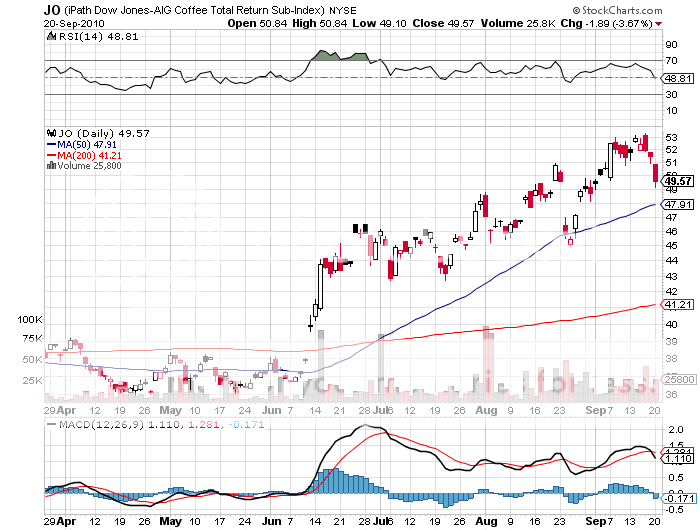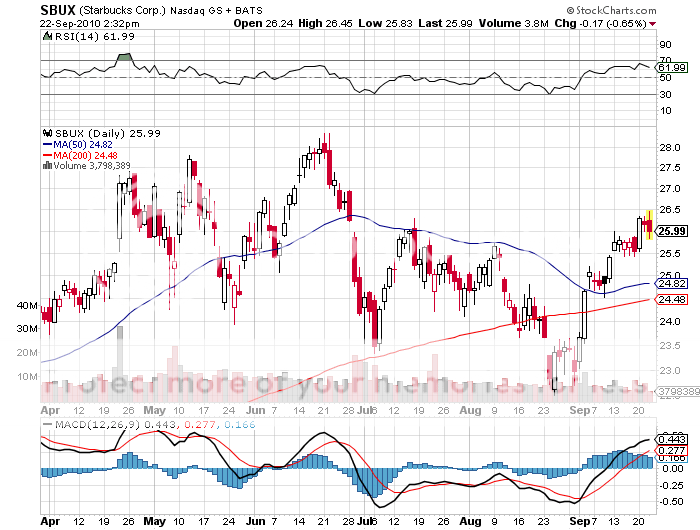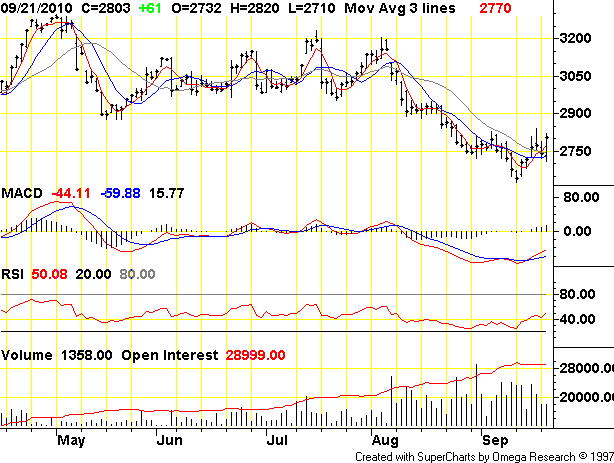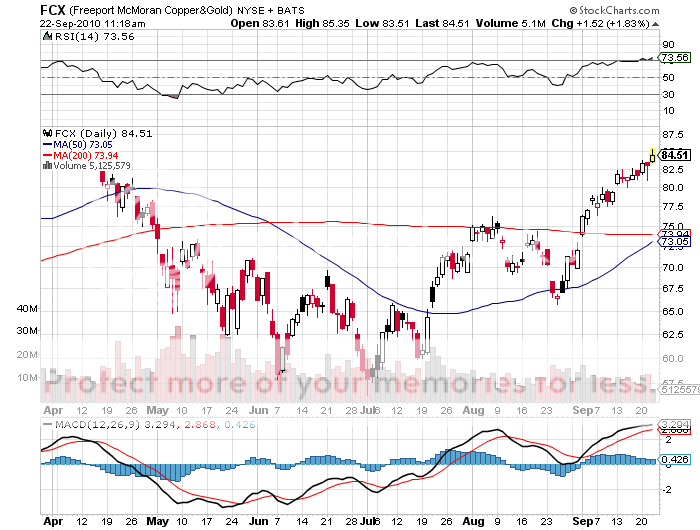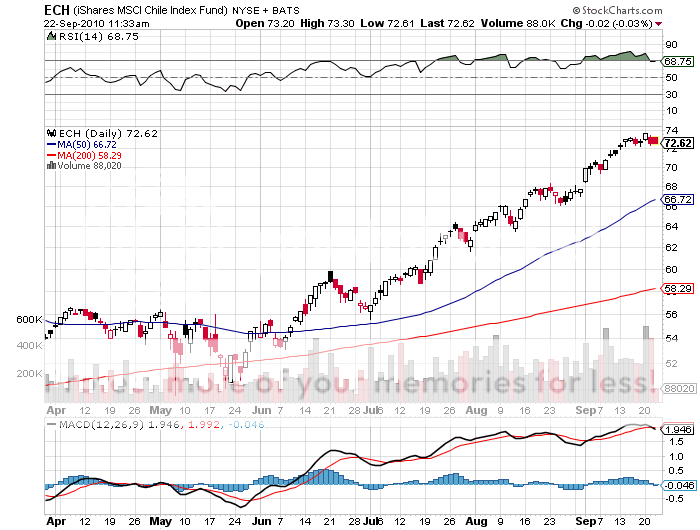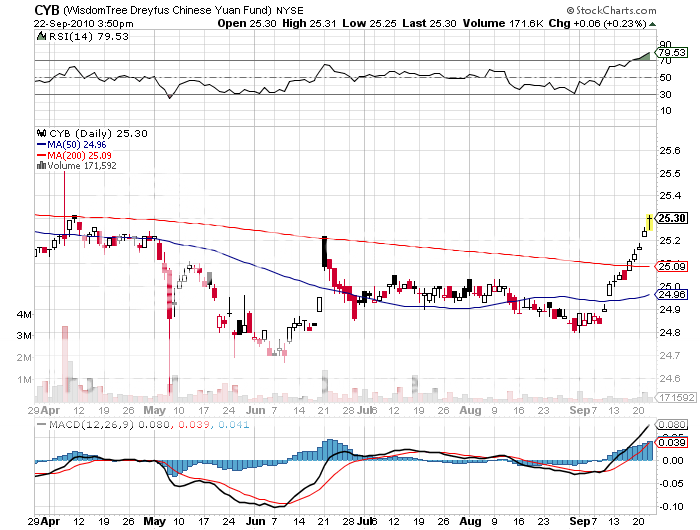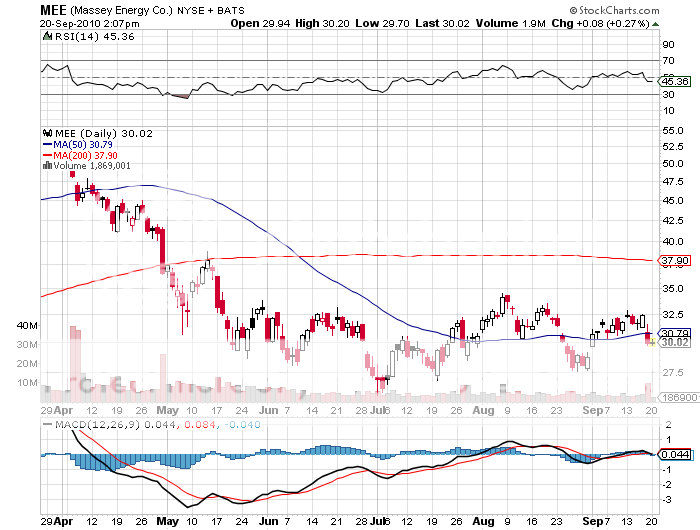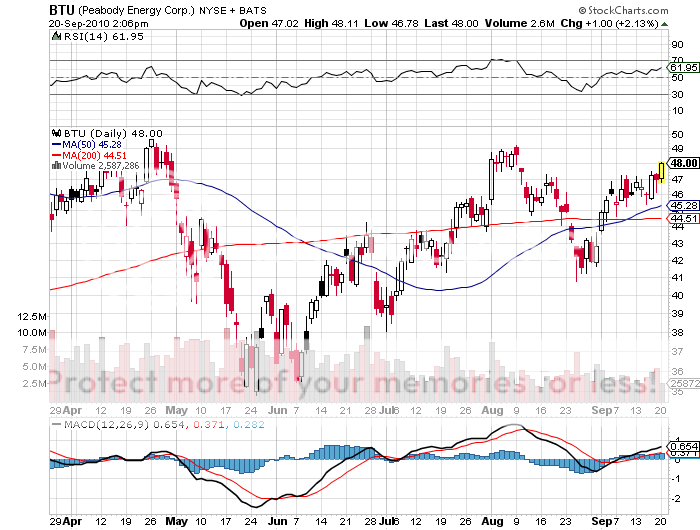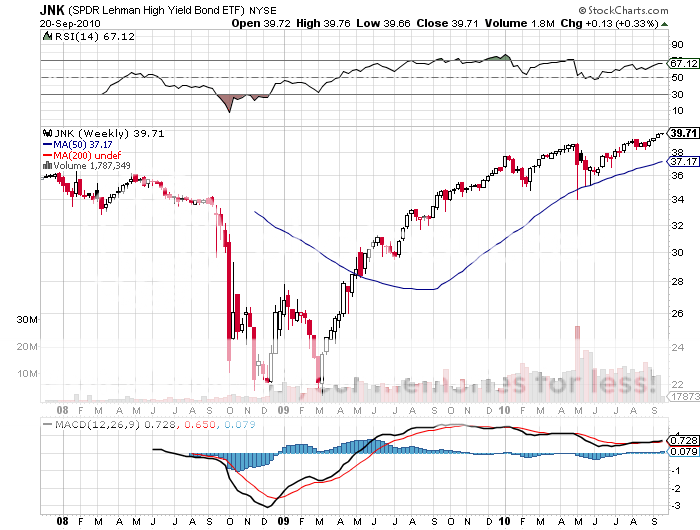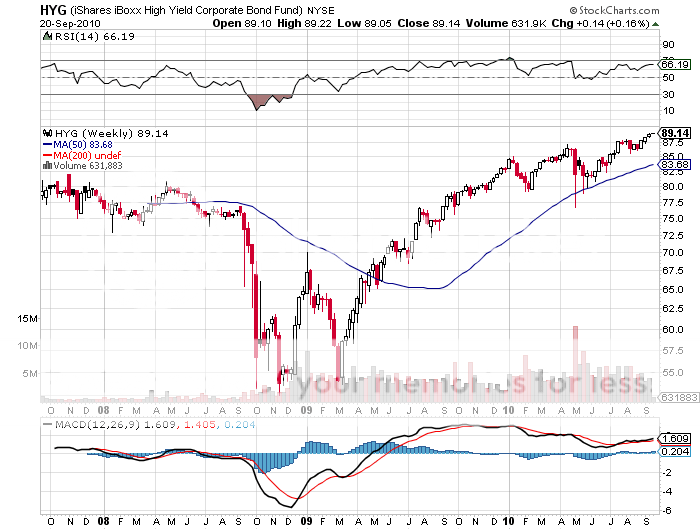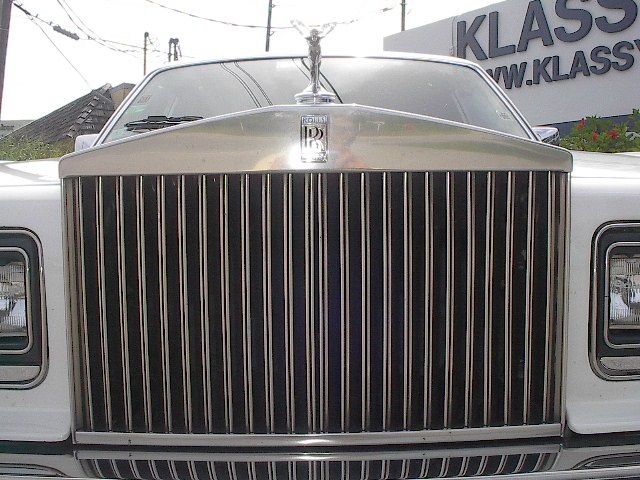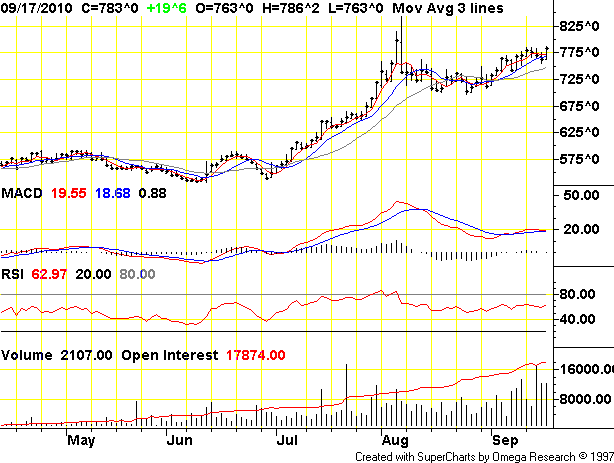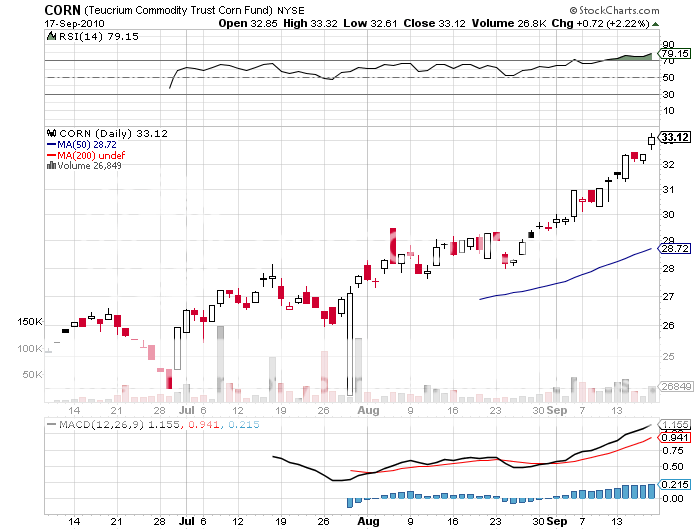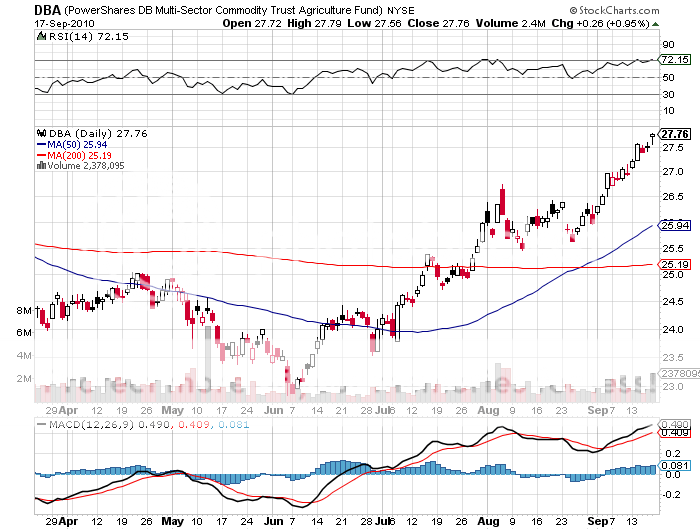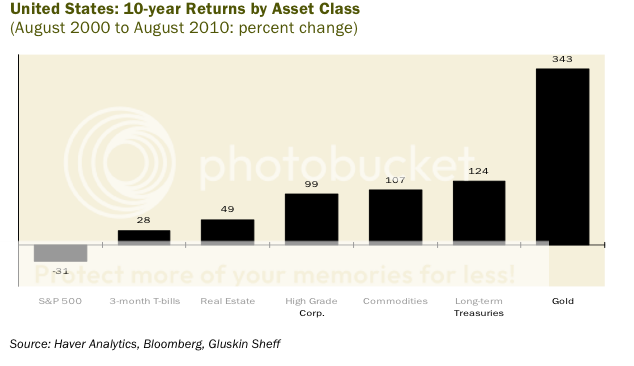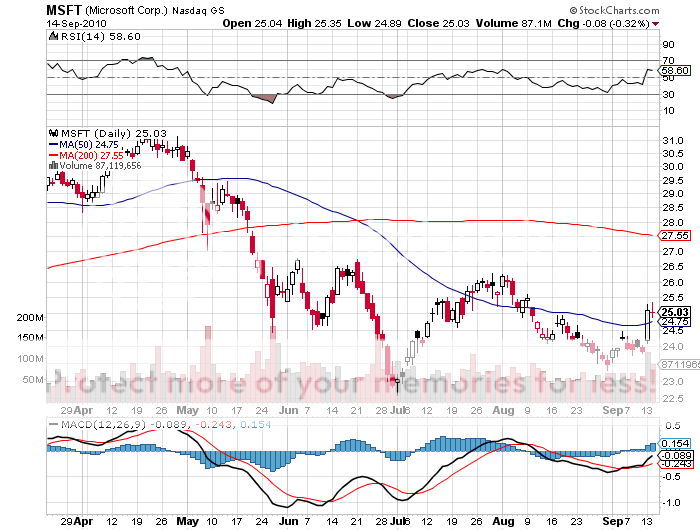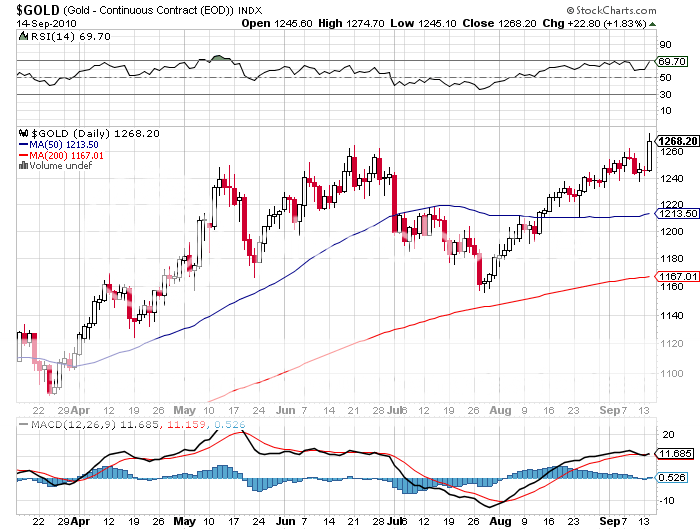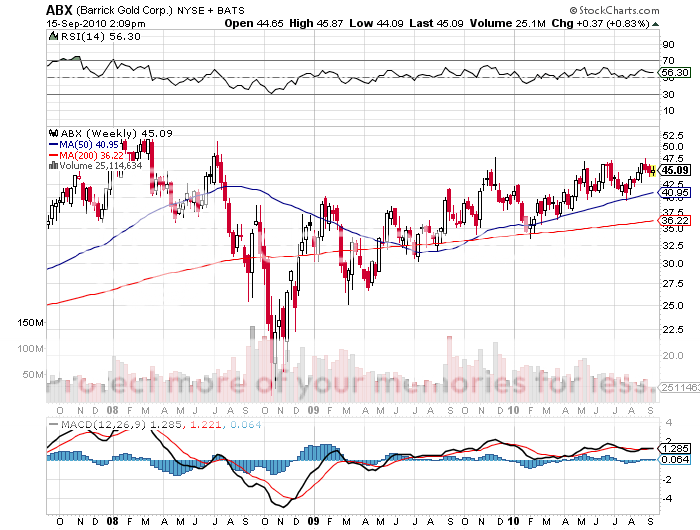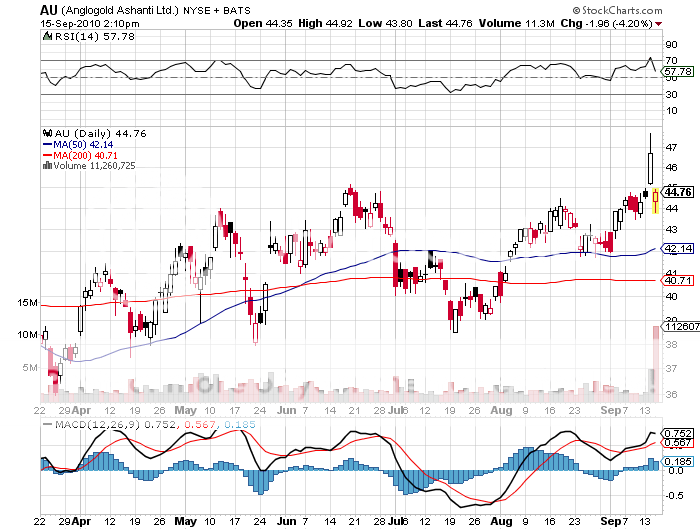
Featured Trades: (COFFEE), (JO), (COCOA), (SBUX)
2) The Markets Develop a Caffeine Habit. Since my last piece on coffee two months ago (click here), the ETF for aromatic commodity (JO) has tacked on 23%, and 42% since I put out my watershed call (click here for 'Going Back Into the Ags').
But this may just be the down payment. Weather in primary producer, Latin America, has been poor. US coffee stockpiles are now at 10 year lows. Major producer Vietnam is threatening to cease exports and start hoarding, as Russia has already done with wheat. Although prices are now at 13 year highs, we may get even more of a jolt out of this trade.
Has anyone thought about shorting Starbucks (SBUX) on this news? They can't keep passing prices on to consumers forever in this deflationary world.? What is the one agricultural commodity that has gone down this summer? Ironically, it is cocoa, where a single hedge fund attempted to corner and create a short squeeze, unsuccessfully, it would appear (click here for 'Hedge Fund Corners the Cocoa Market' ).? Better start stocking up on those 50 pound bags of coffee beans at Costco.
Stockpiling for That Caffeine Habit
Featured Trades: (COPPER), (FCX), (GLD), (KOL), (BHP), (ECH)
3) Upgrading Copper. They say that imitation is the sincerest form of flattery, so I felt like puffing out my chest yesterday when Goldman Sachs (GS) announced an upgrade of Freeport McMoran (FCX), posting a six month target of $96/share. (FCX) is one of the world's largest copper producers, and has a nice little gold business on the side, as the two are often found together. The Vampire Squid said that demand from China was unrelenting, would continue into the foreseeable future, and that it was not all about stockpiling.
I always welcome more investors joining the bandwagon after I have established a position much lower down. Their report adds confirmation to my recent piece on the red metal (click here for 'Is Copper the New Red Gold'). It also bodes well for my call on Chile (ECH) (click here for 'Chile is Looking Hot'). Long time readers know that I have been bullish on copper all year, listing it in my 2010 Annual Asset Review as one of the commodities that will outperform for the next decade (click here for that report).
Like all other hard assets, copper is a direct beneficiary of the QE II rumors now sweeping the financial markets (see above). In the old days, such a move by the Fed ritually delivered strong bond prices and a weak dollar. In the 'new normal' it also triggers a tidal wave of buying things that hurt if you drop them on your foot, like precious metals (GLD), (SLV) industrial metals, coal (KOL), and iron ore (BHP).
These are the 'new dollars' with the unique attributes that they can't be made with a printing press, aren't being made anymore, and the number of potential consumers is growing by 175,000 a day. If you don't believe me, then check out the World Population Clock by clicking here.
Gotta Love Those Hard Assets
Featured Trades: (EMERGING MARKET CURRECIES), (FXC), (FXA)
Currency Shares Canadian Dollar Trust ETF
Currency Shares Australian Dollar Trust ETF
4) Emerging Market Currencies Are on Fire. If you think that emerging stock markets have been hot this year, take a look at their currencies, which are all blasting through to new all time highs. The Malaysian ringgit is up 11.1% against the buck this year, the Thai baht has appreciated by 8.9%, and the Singapore dollar has jumped by 6.8%.
The central banks of these countries have tried to stem the inflows to maintain export competitiveness, as Japan has done, to no avail. The ocean of money pouring in from the big hedge funds has just been too great. Friends who are using 5X leverage modest for the foreign exchange market are reporting windfall returns.
For me, this move was a no brainer to see coming, as internationally strong economies are the basis, not only for bull markets in equities, but virile currencies as well (click here for 'Time to Play the Minor Asian Currencies'). Unfortunately, there are no dedicated currency ETF's for these relatively illiquid currencies, as there thankfully are for the Canadian (FXC) and Australian (FXA) dollars. At least not yet, anyway.
The great thing for the investors in these countries, like Singapore (EWS) (click here for 'Singapore Sizzles' ), and Thailand (TF) (click here for that call) is that this creates a double leveraged effect on profits. Rising foreign shares are worth even more when their currencies are increasing in value too.
Even the Chinese Yuan (renminbi) has been strong, with the People's Bank of China kicking and screaming all the way. Concerns about a generalized dollar collapse have driven the ETF (CYB) up 2% this month. Like everything else in the emerging world, these currencies are overbought for the short term, but should continue to power on for another decade.
Hey Baby, Can You Spare a Baht?
Featured Trades: (MY Q3 PERFORMANCE),
(CORN), (DBB), (SSG),
(GLD), (SLV), (PPLT), (PALL),
(ECH), (TF), (IDX), (TUR), (EPOL), (EWY), (EWS),
(FXJ), (TBT)
1) My Q3 Performance. Today is the autumnal equinox, the day when the sun crosses the equator and heads southward to the Tropic of Capricorn at the 20th parallel. The moon is full, and night becomes longer than day. This is when pagan civilizations sacrificed virgins to assure the return of the sun in the spring.
As my days get longer and the sun sets earlier I find myself completing my daily hike down Mount Diablo late, my contemplations about the market interrupted by packs of howling coyotes, hoping I don't step on a Western rattlesnake in the darkness, yet again. Sometimes I have to skip adding the 30 pound log or rock I use to keep my shoulders and quads in shape. After all, the next forced march in Iraq or Afghanistan is only a phone call away. Until then, the High Sierras will have to suffice as a motivator.
I was expecting a boring summer and got a sizzler instead. Corn (CORN), wheat (DBB), soybeans, sugar (SSG), gold (GLD), silver (SLV), platinum (PPLT), and palladium (PALL), the subjects of years of painstaking research, all paid off big time by going ballistic. Emerging markets in Chile (ECH), Thailand (TF), Indonesia (IDX), Turkey (TUR), Poland (EPOL), Singapore (EWS), and South Korea (EWY) also made generous contributions. I wanted to short the yen (FXJ) and Treasury bonds (TBT), but took a nap instead, sparing myself much grief.
This equinox marked the passing of long time friends, like CNN correspondent John Lewis (click here for the obit) and Murray Sayle (click here for his piece).
It also heralds the onset of the most treacherous time of year for stock investors. There should be some substantial selling to beat imagined increases in capital gains tax rates from 15% to 20%, once the November election is out of the way. There will also be sacrifices of a different sort, as unfortunate managers playing catch up desperately reach for performance. That may be what's powering the current low volume rally in stocks.
I have heard of too many advisors who panicked and sold their clients out, close to the 2009 bottom, chased the market back in front of the 2010 Q2 top, taking yet another hickey. Thus, I expect the bloodletting to be fierce and unforgiving when they are fired in December, such is the cruel and heartless nature of our business.
Looking for Fresh Meat
Featured Trades: (COAL), (BTU), (MEE), (JOYG), (BNR)
1) Is Coal the New Black Gold? After the halting and starting three week rally we have seen in stocks, I would be negligent to recommend equity plays here. But there is one sector you should add to your 'buy on meltdowns' list and that is King Coal.
Demand from emerging markets, especially metallurgical coal needed to make steel, is absolutely exploding. Industry experts say a major super cycle of buying from China, South Korea, Japan, and Taiwan that is creating a long term structural shortage for the black stuff. One of the reasons Warren Buffet's Berkshire Hathaway acquired the Burlington Northern Railway (BNR), was that it obtains 75% of its earnings from transporting coal to west coast ports for shipment to Asia.
The US currently derives 50% of its power generation from burning coal, and that dependence isn't changing any time soon. The only potential drag is the subterranean price of natural gas, to which many coal burning utilities may switch, if prices fall further. Not only do power companies have the environmental incentive to switch to relatively clean burning CH4, it is also cheaper on a dollar per BTU basis. However, this only affects the domestic demand for coal, not the foreign markets.
If the Republicans win the November elections, a regulatory back off will deliver a sudden boost to profitability, and you can count on perceptions to front run that. The new cost of recent regulations brought in by the Obama administration has already been priced in to these stocks. Some of the premier names to look at here include Peabody Energy (BTU), Massey Energy (MEE), and Joy Global (JOYG).
Is It Time to Look Into Coal?
Featured Trades: (JUNK BONDS), (JNK), (HYG), (PHB)
SPDR Lehman High Yield Bond Fund ETF
iShares iBoxx High Yield Corporate Bond Fund ETF
PowerShares High Yield Bond Fund Portfolio ETF
2) Are Junk Bond Investors Paying Rolls Royce Prices for Jalopy Securities? One of my more prescient calls of the past two years has been to move readers into the junk bond arena (click here for my '2009 Annual Asset Class Review'). My argument then was that the market was discounting a default rate of 14%, but that the realized default rate would be a tiny fraction of that.
This turned out to be true, prompting the (JNK) ETF to deliver a parabolic 80% return, not bad for a bond fund. Similar gains were seen in the other junk ETF's, like (HYG), and (PHB). However, it looks like this market is returning to the bad old days that we saw at the last top of this market in 2007. Inferior credits are now flooding the market with dubious conditions, lax covenants, but premium terms, taking new issuance up to an unbelievable $172 billion during the first nine months of 2010. Banks may not be willing to lend, but investors of every stripe are more than happy to. Investors are once again paying Rolls Royce terms for jalopy credits. Apparently the reach for yield knows no bounds.
If you haven't started to sell off your position in this area, I would begin to do so. What seemed like a riskless yield with (JNK) at 18% last year doesn't seem like such a bargain now at 10.8%. Use the current strength in the equity market to take profits at these very rich prices. When credit quality once again becomes an issue, these will be the first securities to drive into the ditch.
Rolls Royce Prices for Jalopy Securities
SPECIAL $5/BUSHEL CORN ISSUE
Featured Trades: (WHEAT), (CORN),
(GOLD), (SILVER)
Teucrium Commodity Trust Corn Fund ETF
SPDR Gold Trust ETF
iShares Silver Trust ETF
ETFS Physical Platinum Trust ETF
ETFS Physical Palladium Trust ETF
1) Wheat Melt Up Warning! Last week, I warned of a short squeeze in corn due to worsening conditions across the entire agricultural front. Since then, the ETF (CORN) has risen ten out of 12 days. That leaves corn severely overbought, and the hot money looking for a new temporary home.
Adding fuel to the flames was the Environmental Protection Agency's announcement today that they would go ahead with an E15 program, gasoline that has a 15% ethanol content, more than the 13% many were expecting. Ethanol itself is up 35% in recent months (click here). I also have to wonder if the fears of quantitative easing sparked by Japan's massive intervention in the foreign exchange market last week was driving some money into the foodstuff sector.
So bring on wheat! Russia has reiterated its export ban until the end of 2011. It is only a question of how much of this year's damage will spill over into next year's crop. Could Russia be forced to import wheat to feed its hungry masses? If you wait long enough, even the unthinkable happens.
It's looking like we are getting an early freeze, and possible snow in Canada, which will decimate crops there. Take a look at the chart below for Hard Red Wheat, which after a doubling in the early summer has been consolidating in a tight range, refusing to sell off. Technical analysts tell me this is a chart that is begging to go up, and could do so at the drop of a hat.
I think you may get a rotation out of corn and into wheat that could trigger another melt up in this essential foodstuff. This is already happening in the other bull markets I have guided you into. Look at how the buying in gold (GLD) and silver (SLV) has spilled over into platinum (PPLT) and palladium (PALL), and even the rare earths (click here for 'Peak Rare Earths is Upon Us' ). Ditto with the agriculture area, with Potash (POT) providing a jolt to Mosaic (MOS) and Agrium (AGU).
What is the big picture here? Buy hard stuff and avoid paper. The government can create all of the Treasury bonds and dollars it wants. Calories of sugar, bushels of corn, barrels of oil, and ounces of precious metals are another story.
Regrettably, the Teucrium people have not been able to get their wheat ETF off the ground yet, so you may have to open a futures account to capture this one. The symbol is MWH1. The usual caveats apply here. Wheat is not the screaming buy that it was when I first recommended the ags in June (click here for Going Back Into the Ags), so keep the appropriate risk control measures and stops in place.
This is the Way to Launch a New ETF!
Printing Presses Not Welcome Here
SPECIAL $5/BUSHEL CORN ISSUE
Featured Trades: (GOLD), (SILVER)
2) Silver Blasts Through $21! Gold hit a new high too at $1,284, and the yellow metal seems hell bent on taking out $1,300 before it takes a rest. The street was bubbling today with rumors of some leveraged gold traders getting margin calls on their shorts. A major incentive last week was Japan's massive $21 billion intervention in the foreign exchange markets to drive down the yen. Some believe that this is only the opening shot in a global attempt at quantitative easing in the run up to the November elections that will debase all paper currencies to the benefit of all hard assets.
The silver move carries broader implications in that with 50% of demand coming from the industrial sector, strength here suggests that the economy may be stronger than the 'double dippers' realize. I never have been of the double dipper persuasion myself, instead believing that we would get real growth, but growth that is a shadow of its former self (click here for 'Here Comes the Square Root Shaped Recovery').
However, I did expect several double dip scares. That's why I was pulling the fire alarm about equity exposure in April (click here for 'How Can the US Go Up and China Go Down' ). Such a scare certainly showed its ugly face this summer. Perhaps investors are looking at the chart below of ten year returns by asset class showing that gold has been trouncing all comers since 2000, with the yellow metal bringing in a blistering 343% return, versus a 31% loss for the S&P 500.
Featured Trades: (MSFT)
1) Another Sign of a Bond Market Top. As much as I like it, I am not accustomed to getting such instant gratification when I pick up a stock tip. But that is precisely what happened when Bill Fleckenstein told me he liked Microsoft (MSFT) at $23 last week (click here for my radio interview with Fleck).
Since then the stock has popped 10%.
There were rumors yesterday that the company was planning to issue long term bonds at current subterranean interest rates and use the proceeds to buy back its own shares, which are selling at a modest ten times earnings. At these terms, Mr. Softy should be doing this trade until the cows come home.
It reminds me of the type of financial engineering I saw in Japan during the late eighties, where companies could issue debt with attached five year equity warrants at 0% interest rates. Almost all of these warrants ended up expiring out of the money because of the stock market crash that followed, so the borrowers were able to obtain free money for five years. For leveraged, capital intensive industries this can have a huge impact on profitability. US companies were paying 8% for medium term money then. When investors are stupid enough to make these deals possible, the astute managers should take the gift.
If (MSFT) goes ahead with the plan, and they'd be nuts not to, it could only be great news for the stock. Microsoft has recovered from its disastrous Vista operating system, and is now hitting on all cylinders with a series of successful new product launches. A share price of $30 should be in the cards.
Can Microsoft Get Something for Nothing?
Featured Trades: (GOLD), (ABX), (AU), (GLD)
SPDR Gold Trust Shares ETF
2) More Reasons to Buy Gold. As a four decade observer of the global financial markets, I often see a situation where the higher a price goes, the more reasons for it to rise come out of the woodwork. That is happening with gold now.
Yesterday, I learned that Anglo Gold Ashanti is spending $1.375 billion to take its gold hedges off. The obvious implication here is that they have studied the long term supply and demand for the lustrous product, and believe that the downside risk no longer exists. When an organization with far more massive resources than I reaches such a conclusion, should I follow suit? Barrack Gold (ABX) did the same a year ago, and the move was one of the sparks that ignited the jump in the yellow metal from $950 to $1,200.
And then I read in the Financial Times today that central banks are planning to buy 15 tonnes of the barbarous relic in 2010, flipping them from net sellers to net buyers for the first time in 20 years (click here for my piece predicting this seven months ago). For the past decade, central banks averaged 442 tonnes/year in sales. Gone are the perpetual rumors of the elusive 400 tonne IMF sale that overhung the market. It seems the list of emerging market central banks loading up on gold is growing by the day. I think the outlook for the value of my gold teeth is looking pretty good these days.

